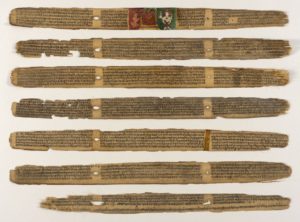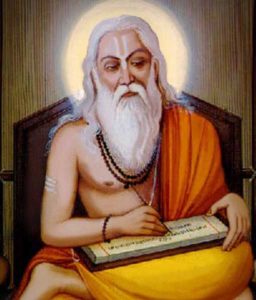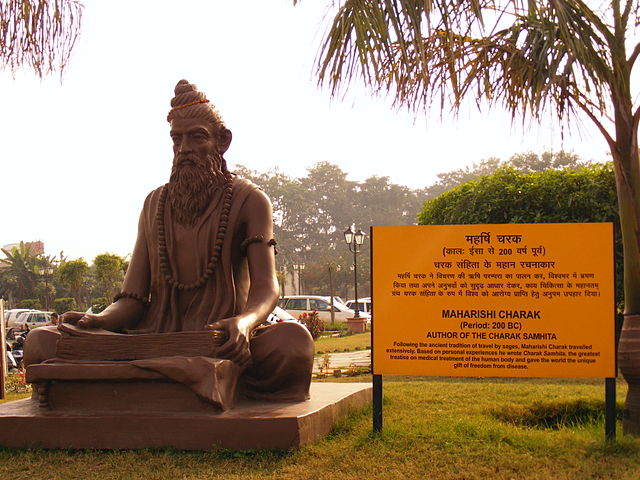 The Charaka Samhita is found to have written around 400-200 BCE. It is known to be one of the oldest and the most important ancient authoritative texts on Ayurveda. Acharya Charaka is one of the greatest figures in Indian medical history. He systematized and codified many aspects of ancient Indian medical tradition. His work is considered to be one of the most authoritative writings on Ayurveda. This work is sometimes considered a redaction of an older and more voluminous work, Agnivesha Samhita (46,000 verses), which is no longer in existence . Dridhabala, living about 400 AD, is believed to have filled in many verses of missing text (perhaps up to 20%) in the Chikitsasthana and elsewhere, which disappeared over time.
The Charaka Samhita is found to have written around 400-200 BCE. It is known to be one of the oldest and the most important ancient authoritative texts on Ayurveda. Acharya Charaka is one of the greatest figures in Indian medical history. He systematized and codified many aspects of ancient Indian medical tradition. His work is considered to be one of the most authoritative writings on Ayurveda. This work is sometimes considered a redaction of an older and more voluminous work, Agnivesha Samhita (46,000 verses), which is no longer in existence . Dridhabala, living about 400 AD, is believed to have filled in many verses of missing text (perhaps up to 20%) in the Chikitsasthana and elsewhere, which disappeared over time.
Acharya Charaka
 Acharya Charaka has not mentioned his place of birth and proper infrotuction anywhere in Charak Samhita which create curiosity among various historical and ayurveda practioners. But he quoted north-west regions of India such as Himalaya, Panchala Kshethra, Kailash and Panchandapura etc. All these above references suggest that, Charaka may have hailed from the North-West region of India. Charaka is considered as a son of Vishudha Krishi and a desciple of Vaishampayan
Acharya Charaka has not mentioned his place of birth and proper infrotuction anywhere in Charak Samhita which create curiosity among various historical and ayurveda practioners. But he quoted north-west regions of India such as Himalaya, Panchala Kshethra, Kailash and Panchandapura etc. All these above references suggest that, Charaka may have hailed from the North-West region of India. Charaka is considered as a son of Vishudha Krishi and a desciple of Vaishampayan
Charaka Samhita
The Charaka Samhita is a huge treatise on ancient Indian medicine. It was writtedn in Sanskrit language. It is voluminous text composed in both prose and poetry form. Poetry was known to serve as means to memorize the verses. The poetric style of the verses helped the students of Ayurveda memorize the sutras.
Charaka Samhita consists of 9295 Sutras and 120 Adhyayas(Chapters). The number 120 appears to bear some significance because, Ashtanaga Hridaya, Kashyapa Samhita and Bhela Samhita also contain 120 chapters each. in Charak Samhita, Adhyayas are distributed into Ashtanga Sthana (Eight Sections) Each section is further divided into numerous sub sections.
Sections of Charaka Samhita
| Sr.No | Name of Sthana | Total Chapters | Total Verses | Total Prose |
|---|---|---|---|---|
| 1 | Suthrasthana | 30 | 1670 | 283 |
| 2 | Nidanasthana | 08 | 103 | 146 |
| 3 | Vimanasthana | 08 | 88 | 267 |
| 4 | Sharirasthana | 08 | 236 | 183 |
| 5 | Indriyasthana | 12 | 381 | 38 |
| 6 | Chikitsasthana | 30 | 4961 | 142 |
| 7 | Kalpasthana | 12 | 330 | 48 |
| 8 | Sidhisthana | 12 | 649 | 52 |
| Total =8 | 120 | 8419 | 1111 |
Sutrasthana
Charak Samhita starts with Sutrasthana which deals with various important fundamentals and basic principles of Ayurveda. It is the brain of whole samhita. Here there is a collection of various important shlokas related to various context are described. Therefore this sthana is also known as Shlokasthana. This sthana consists of total 30 chapters. The first 29 chapters are arranged in 7 groups of four chapters each and last two chapters are Sangraha (summary) of the entire Ayurvedic science. Ayurvedavatarana (transmission of Ayurveda), definition and objective of Ayurvedaare mentioned in detailed here. Snehakarma (Oleation) and Swedakarma (sweat therapy) and the cause of the illness are discussed.
Qualities of the Vaidya (physician), Rogi (patient), Oushadi (proper drug), Paricharak (compounder) and royal physician is mentioned very beautifully. Relation of doctor with patient is also described in detailed. Method of construction of healing centre (hospital) is elaborated. It also mentioned that treatment by quacks and warns that a person hit by lightning has a better chance of survival than a patient who falls into the hands of a quack physician.
The composition of drug and the mode of drug action are also described here. Various attributes of foods ingredients including method of preparation and effects of foods ingredients on the human body are also described. Daily and Ritucharya (monthly regimes) and the set of laws associated with it, all about Adharniya vega (natural urges), all the four factors of therapeutics, considerations before treatment qualities, function, their sites of manifestation and treatment of the Doshas. Universality and eternity of Ayurveda is also explained. In short the essence of the whole treatise is wrapped beautifully in this sthana.
Nidana Sthana
This is the second sthana of Charak samhita. This sthana deals in detail with the Nidana (etiology), Samprapti (pathogenesis), Purvarupa (prodromal sign and symptoms), Rupa (Clinical features) and prognosis of the diseases are described in detailed. In this sthana only 8 diseases are described because these diseases may predominant at the time of Acharya Charak. They are – Jwara (fever), Raktapitta (Bleeding disorders), Gulma (abdominal lump), Prameha (diabetes mellitus), Kushta (leprosy or skin disorders), Shosha (tuberculosis), Unmada (insanity) and Apasmar (epilepsy). These diseases are also known as Mahavyadis. In some cases principles of treatment is also furnished.
Vimana Sthana
This is the third sthana of Charak samhita. In this sthana 8 chapters are described. The properties of taste, quantity of food, causes and management of Janpaddhwansa (epidemics diseases) is also described. Here detail descriptions about Srotas (channels of circulation), Aamashaya (stomach), 20 types of Krimi (parasites), Dwividha pariksha (two methods of examination), Trividha Pariksha (three methods of examination) and Dashavidha rogi pariksha (ten factors for examination of patient) is available. Examination of Vaidya (physician), Rogi (patient) and Oushadi (proper drug) is described in detailed. 4 types of Agni (factors responsible for digestion and metabolism) is also described .The logical ways of arriving at a diagnosis namely, observation, inference and interrogation and methods of study and teaching also discussed in this part. In Vimanasthana three methods of obtaining knowledge are described. They are procedure of study, procedure of teaching and procedure of debates. In the end of this sthana, guidelines for participating in the debates are also described. Some important fundamental principals are also explained here.
Sharira Sthana
This is the fourth sthana of Charak samhita. This sthana comprises of total 8 chapters. In this sthana,there is a detail description of about anatomy and physiology of body. It also describes composition of body and factors responsible for growth of body.
Proof of existence of Atman (soul) is given here. This sthana includes the description of the theory of birth and death. It describes the creations of universe and the human body. It also describes nature of human being, nature of mind and causes of diseases. Monthly development of the embryo, factors injurious to the growth of embryo and sign of bicardic stage of pregnant woman is also described. Description of organs and parts of the human body is also furnished here. Kaal and akaal mritu (timely and untimely death) and factors responsible for the maintenance of normal span of life is explained in detailed.
Indriya Sthana
This is the fifth sthana of Charak samhita. This sthana comprises of 12 chapters. In this sthana six types of Prakruti (natural disposition) are mentioned. Sign of imminent death and premonitory sign of sudden death is also discussed. 7 types of dream and their various results and process of manifestation of dreams are also mentioned. Prognosis of diseases and fatal sign are described on the basis of various descriptions regarding Swapna (dream), Swara (voice), Gandha (smell), Prabha (luster), Chaaya (shadow) Pratichaaya (reflected shadow) Rasa (taste) and Sparsha (touch).
Chikitsasthana
This is the sixth sthana of Charak samhita. In this sthana, various diseases and their principal of treatment are described in detailed. This Sthana consists of 30 chapters out of which first chapter i.e. Rasayana Chikitsa (Rejuvenation Therapy) is divided into 4 sub – chapters namely (Abhaya Aamlakiya Rasayana Paad, Pranakamiya Rasayana Paad, Karaprachitya Rasayana Paad, Ayurvedsamithiya Rasayana Paad) and second chapter i.e. Vajikarana Chikitsa (Aphrodisiac therapy) is also divided into 4 sub – chapters namely (Sanyogasharmuliya Vajikarana Paad,
Aasiktakshirikama Vajikarana Paad, Mashparnabhratiyam Vajikarana Paad, Pumaanjatabaladikam Vajikarana Paad). In remaining 28 chapters there is a description of various diseases, treatment and Nidan parivarjan(avoiding the causative factors) are beautifully discussed.
Kalpasthana
This is the seventh sthana of Charak samhita. This sthana contains total 12 chapters. This sthana deals exclusively with the various formulations of Vamaka dravyas (emetic drugs) and Virechaka dravyas (purgatives drugs) which are essential during Panchakarma. These all 12 chapters are supplemented by Acharya Dridhabala.
Siddhisthana
The eight and last sthana of Charak samhita comprises of total 12 chapters. In this sthana there is a detailed description of Panchakarma therapy. Essential karma like Snehan karma (Oleation Therapy), Swedan karma (Fomentation Therapy), Vaman karma (Emesis Therapy), Virechana karma (Purgation Therapy), Asthapana basti (medicated enema of decoctions and medicated oils), Anuvasana basti (medicated oil enemas) and Uttar basti (Useful in genitourinary diseases and infertility of female). There is also description of complications arising due
to improper administration of drug and with their managements. In this sthana 36 types of Tantrayuktis are mentioned. These all 12 chapters of Siddhisthana are supplemented by Acharya Dridhabala. Importance of Charak samhita is nicely and elaborately explained in detailed.
Conclusion
The Charak samhita is famous as one of the remarkable accomplishments of ancient Indian science. All these credit of goes to Punarvasu Atreya, Agnivesha, Acharya Charak and Kashmiri Pandita Dridhabala who are the Preceptor,
composer, redactor and amender respectively. Through his genius and intuition, Acharya Charak made landmark contributions to Ayurveda. He forever remains etched in the annals of history as one of the greatest and noblest of rishi-scientists.
Charak samhita covers all aspects of medical science with special importance to Kaya Chikitsa and remains par excellent on that subject. Charak samhita not only gives knowledge about Ayurveda in its totality but also explain the logic and philosophy on which this system of medicine is based. Therefore his renowned work, the “Charak samhita”, is considered as complete encyclopedia of Ayurvedic science.
Teachers of India – Acharya Charaka
Reference: IJAAM.org
Image Courtesy:Wikipedia
You may also like
-
India Against Mpox
-
Combination of ‘Siddha’ Drugs Reduces Anemia in Adolescent Girls: Study
-
Suspected Mpox Case Under Investigation; Patient Put Under Isolation, No Cause for Alarm
-
Prime Minister Applauds India’s Best Ever Performance at the Paralympic Games
-
National Exit Test (NExT) for Ayush to be Effective from 2021-2022 Batch: Union Minister of Ayush Shri Prataprao Jadhav
